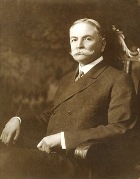When I first ran across the rantings of George Maxwell as the Colorado River Compact was being developed in the 1920s, their racism seemed almost comical. Here he is in a written submission to the 14th Meeting of the Colorado River Commission, Nov. 13, 1922 (pdf from University of Colorado):
The flood menace must not be used as a ‘stalking ox’ behind which to conceal a plan to create an Asiatic Menace in Mexico more dangerous by far to the United States of America than the original flood menace.
As between the submergence of the Imperial Valley by floods and the devastation of Southern California and Arizona in an Asiatic War, the loss of the Imperial Valley would be the lesser of the two evils.
Maxwell’s fear was that any water allowed to pass into Mexico would be used in the development of an “Asiatic” irrigation colony that would be used as a beachhead for an invasion of the United States. Here’s historian Eric Boime:
This is not just some crazy old racist. George Maxwell was a pioneer of the reclamation movement, one of the authors of the key legislation that brought federal policy and money to bear on the Colorado River. I’m intrigued by Maxwell because in the years after the 1922 approval of the Colorado River Compact, he was enormously influential in Arizona, persuading state officials not to ratify the compact – a stand that continues to echo in contemporary water management.By 1923 his long, meandering letters to former acquaintances at the U.S. Geological Survey, sometimes spaced only twenty-four hours apart, fretted about “Asiatic cities” at the head of the Gulf of California, capable of launching “a fleet of aeroplanes [sic] with poison gas enough to wipe out the population of southern California some morning before breakfast.”
Boime, in his fascinating essay “Beating Plowshares into Swords”: The Colorado River Delta, the Yellow Peril, and the Movement for Federal Reclamation, 1901–1928 (Pacific Historical Review Vol. 78, No. 1, February 2009, paywalled) points out that Maxwell died penniless and ignored. But what I did not realize until I read Boime was the remarkable racial underpinnings of the early reclamation movement. The story of reclamation’s aspirations to social engineering has been often told – the way an empire of 160-acre farms would lure Americans from urban decay into an idyllic pastoral future, one family at a time. What I’d not previously understood was the rich, full racism of the vision.
Here, for example (as quoted in Boime) is the Imperial Board of Supervisors in a 1919 Congressional hearing:
“If we build an all-American canal, we will have [thousands of] free, prosperous Americans building homes and schoolhouses on land watered by water that has never touched a foreign soil and water that . . . Japs and Chinese have not used to bathe in.”
And here is Boime’s description of the views of no less a reclamation luminary than Elwood Mead, who headed the Bureau of Reclamation during the historic construction of the dam at Boulder Canyon (they named a big reservoir after him):
Mead perceived industrious, upwardly mobile Japanese to be the greatest menace to American rural life. If, in fact, Anglo-Saxon family farmers were the key to revitalizing the nation’s institutions, non-Anglo-Saxon family farmers would be the source of their ruin. Japanese agricultural success, Mead asserted, stemmed from “ancient, alien instincts” that would surpass the “American individualist [like] child’s play. . . . Anglo-Saxons and Mongolians cannot live side by side,” he argued, “and neither will give way to the other without a conflict.”
So yeah, George Maxwell may have been batshit crazy at the end (“aeroplanes with poison gas”) but his views on irrigation and race were not terribly far from the mainstream of his day.
Biographical background on George Maxwell from the Arizona State Library.

